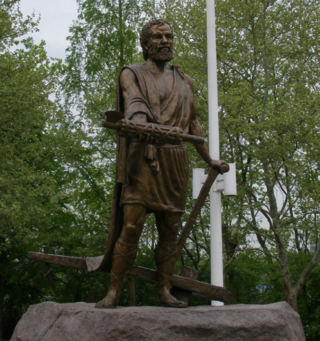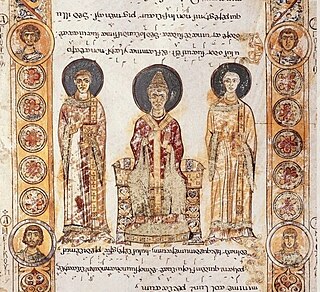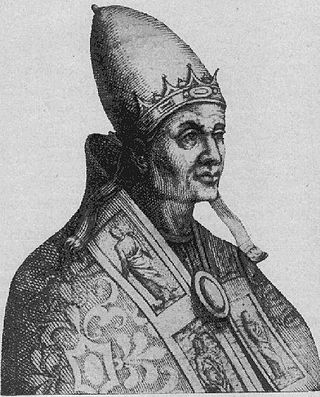
Pope Anastasius III was the bishop of Rome and ruler of the Papal States from April 911 to his death.

Pope Benedict VIII was bishop of Rome and ruler of the Papal States from 18 May 1012 until his death. He was born Theophylact to the noble family of the counts of Tusculum. Unusually for a medieval pope, he had strong authority both in Rome and abroad.
Pope Sergius III was the bishop of Rome and nominal ruler of the Papal States from 29 January 904 to his death. He was pope during a period of violence and disorder in central Italy, when warring aristocratic factions sought to use the material and military resources of the papacy. At the behest of Theophylact I of Tusculum, Sergius seized the papal throne from Antipope Christopher, who in turn had deposed Pope Leo V. Sergius' reign was subsequently marked by Theophylact's influence. As pope, Sergius continued many ecclesiastical controversies of his predecessors, including conflict over Pope Formosus' legacy, annulling all ordinations made by the late pope, and the filioque controversy with eastern patriarchs. His pontificate was similarly marked by temporal conflicts, with Sergius' refusal to crown Berengar I of Italy as Holy Roman Emperor, and his support of Byzantine Emperor Leo VI the Wise's fourth marriage. Sergius also saw the restoration of the Lateran Palace.

Marozia, born Maria and also known as Mariuccia or Mariozza, was a Roman noblewoman who was the alleged mistress of Pope Sergius III and was given the unprecedented titles senatrix ("senatoress") and patricia of Rome by Pope John X.
Pope John XIII was the bishop of Rome and ruler of the Papal States from 1 October 965 to his death. His pontificate was caught up in the continuing conflict between the Holy Roman emperor, Otto I, and the Roman nobility. After long and arduous negotiations, he succeeded in arranging a Byzantine marriage for Otto II, in an effort to legitimize the Ottonian claim to imperial dignity. He also established church hierarchy in Poland and Bohemia.

Lucius Quinctius Cincinnatus was a Roman patrician, statesman, and military leader of the early Roman Republic who became a legendary figure of Roman virtue—particularly civic virtue—by the time of the late Republic.

Pope John XIX, born Romanus, was the bishop of Rome and ruler of the Papal States from 1024 to his death. He belonged to the family of the powerful counts of Tusculum, succeeding his brother, Benedict VIII. Papal relations with the Patriarchate of Constantinople soured during John XIX's pontificate. He was a supporter of Emperor Conrad II and patron of the musician Guido of Arezzo.

The gens Mamilia was a plebeian family at ancient Rome during the period of the Republic. The gens was originally one of the most distinguished families of Tusculum, and indeed in the whole of Latium. It is first mentioned in the time of the Tarquins; and it was to a member of this family, Octavius Mamilius, that Lucius Tarquinius Superbus, the seventh and last King of Rome, betrothed his daughter. The gens obtained Roman citizenship in the 5th century BC, and some of its members must subsequently have settled at Rome, where Lucius Mamilius Vitulus became the first of the family to hold the consulship in 265 BC, the year before the First Punic War.
Pope John X was the bishop of Rome and nominal ruler of the Papal States from March 914 to his death. A candidate of the counts of Tusculum, he attempted to unify Italy under the leadership of Berengar of Friuli, and was instrumental in the defeat of the Saracens at the Battle of Garigliano. He eventually fell out with Marozia, who had him deposed, imprisoned, and finally murdered. John’s pontificate occurred during the period known as the Saeculum obscurum.

Tusculum is a ruined Roman city in the Alban Hills, in the Latium region of Italy. Tusculum was most famous in Roman times for the many great and luxurious patrician country villas sited close to the city, yet a comfortable distance from Rome.
Theophylact I was a medieval count of Tusculum who was the effective ruler of Rome from around 905 through to his death in 924. His descendants controlled the papacy for the next 100 years.

The counts of Tusculum, also known as the Theophylacti, were a family of secular noblemen from Latium that maintained a powerful position in Rome between the 10th and 12th centuries. Several popes and antipopes during the 11th century came from their ranks. They created and perfected the political formula of noble-papacy, wherein the pope was arranged to be elected only from the ranks of the Roman nobles. The Pornocracy, the period of influence by powerful female courtesans of the family, also influenced papal history.
Alberic I was the Lombard Duke of Spoleto from between 896 and 900 until 920, 922, or thereabouts. He was also Margrave of Camerino, and the son-in-law of Theophylact I, Count of Tusculum, the most powerful man in Rome.

Crescentius the Elder, also known as Crescenzio de Theodora, was a politician and aristocrat in Rome who played a part in the papal appointment.
Ptolemy II was the count of Tusculum and consul of the Romans from 1126 to his death. He was the son and successor of Ptolemy I.

Gregory I was the Count of Tusculum sometime between 954 and 1012. Consul et dux 961, vir illustrissimus 980, praefectus navalis 999. He was the son of Alberic II, and Alda of Vienne. His half-brother was Pope John XII.
Gregory II was the son of Alberic III, Count of Tusculum and Ermelina. He was the Count of Tusculum and the Lateran from 1044 to his death.
Alberic III was the Count of Tusculum, along with Galeria, Preneste, and Arce, from 1024, when his brother the count Roman was elected Pope John XIX, until his own death. He was a son of Gregory I and Maria, brother of Popes Benedict VIII and John XIX, and brother-in-law of Thrasimund III of Spoleto.
Marcus Furius Camillus was a Roman senator and a close friend of the emperor Tiberius. Despite being without previous military experience, he enjoyed several successes against the Numidian rebel Tacfarinas while serving as governor of Africa, and was even praised in public by the Emperor and awarded triumphal honours. The historian Tacitus, in his Annales, joked that Camillus subsequently lived invisibly enough to survive this great honour.

The Tusculan Papacy was a period of papal history from 1012 to 1048 where three successive relatives of the counts of Tusculum were installed as pope.










